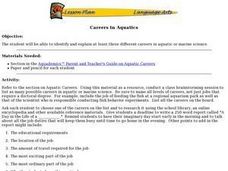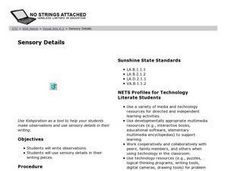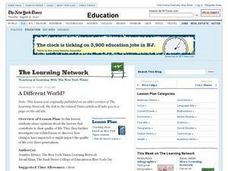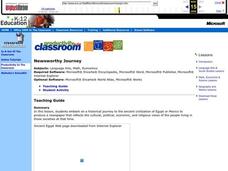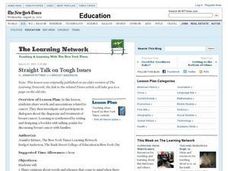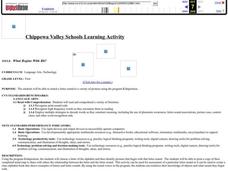Curated OER
December Holidays:Create A Comparison Chart
How are Christmas, Chanukah, Kwanzaa, Las Posadas, and Ramadan similar? How are they different? Learners research the different December holiday celebrations around the world and compare the dates, symbols, countries, foods, and stories...
Curated OER
Careers in Aquatics
Students discuss careers related to aquatic or marine science. They write a report called "A Day in the Life of a (blank)." After reports are completed, if possible a person working in the field of aquatic or marine science is invited to...
Curated OER
Sensory Details
Students observe their environment and write detailed, sensory-specific sentences about that environment. This activity can be extended to include the creation of a personalized story or movie of the experience (student examples are...
Curated OER
Unlikely Communicators: Carrier Pigeons
Second graders explore information about carrier pigeons and other means of communication. They describe different types of communication and transportation and identify their advantages and disadvantages They develop a Communication...
Curated OER
Let's Sleep on It
Learners research sleep following a class discussion on an article in The New York Times. Students use their research information to create a health and wellness exhibit that addresses topics related to sleep.
Curated OER
Do You Know Your Health IQ?
Students define common medical terms. they prepare quizzes on health-related topics to administer to both peers and adults. They write analysis papers based on their findings.
Curated OER
A Different World?
Students share their opinions in a brainstorming session on the factors that contribute to their quality of life. They read the article "Life Is Better; It Isn't Better. Which Is It?," from the NY Times and discuss the article as a...
Curated OER
Something Fishy?
Students try to draw and identify a jellyfish from a physical description. After reading an article, they discover new information about cnidarians. In groups, they research and develop dioramas about a specific cnidarian species. They...
Curated OER
Who Gives a Hoot?
Learners look at owl migration and its impact on the environment and the food chain after reading an article from The New York Times. Students then apply this information to and research different food chain situations for other species...
Curated OER
DNA-B-C's
Young scholars review what they already know about DNA. After reading an article, they discover a new technique to map the course of evolution. In groups, they create ways to present this material to younger children and research DNA's...
Curated OER
Team Works
Students define "group" and list American social and political movements throughout history. They examine one model of a successful team and positive group mentality by reading and identify the traits of a successful group and those of...
Curated OER
A Nobel Cause
Students research the lives and accomplishments of Nobel Prize-winning scientists and compose stories about what the world would be like without the accomplishments of these scientists.
Curated OER
Brick Memorial Flyer
Students conduct research using the internet, school server and newspapers on the history of the brick memorial for veterans and its developmental process. They create and design a three column page layout for a brochure using Microsoft...
Curated OER
Marvelous Mysteries
Fifth graders explore mystery stories. In this reading and writing lesson, 5th graders complete a planning guide for an original mystery. Students use the writing process to create a mystery story.
Curated OER
Newsworthy Journey
Students conduct Internet research about ancient civilizations to produce a newspaper that reflecting the cultural, political, economic and religious views of the ancient civilizations of Egypt or Mexico.
Curated OER
The Forbidden City
Learners compare and contrast life in Beijing, China within the walls of the Forbidden city during the last imperial dynasty to that of city life after the Cultural Revolution. They research and write a footnoted paper that is peer...
Curated OER
It's A Mystery To Me
Young scholars become both mystery readers and writers. They utilize the Internet to understand the elements of this classic genre; employ critical thinking skills when reading various stories in both print and electronic formats; form...
Curated OER
Straight Talk On Tough Issues
Learners engage in a lesson that is focused upon the concept of breast cancer and research is conducted using a variety of reference sources. They reflect upon how different people deal with the tragedy of cancer and then students write...
Curated OER
What Begins With Bb?
First graders match letter sounds to pictures they represent. In this matching letter sound lesson plan, 1st graders use the computer program Kidspiration to match the letter sounds to the corresponding pictures. This can be used for 1...
Curated OER
Debating the Bomb
Students research the repercussions of the development of the atomic bomb. In this history lesson, students read, reflect and discuss nuclear warfare and how it affected the population when it was introduced, as well as how it continues...
Curated OER
We Are One World
Learners access prior knowledge to choose a country and research the living conditions in that country. In this living conditions lesson, students recognize the differences and similarities of conditions of another country to ours....
Curated OER
Earth Science
Students explore the planets and celestial bodies in our solar system. In this outer space lesson, students identify the planets and record journal information about them and other celestial bodies. Students define outer space words.
Curated OER
African American Inventors Society
Young scholars examine the inventions of African Americans and how their inventions contributed to the common good. In this African American inventions instructional activity, students research the inventions of African Americans and...
Curated OER
Naked to the Eye
Students understand that microorganisms are too small to see but there are other indications they exist. For this microorganisms lesson, students recognize that some microorganism are helpful and some are not. Students use a microscope...



